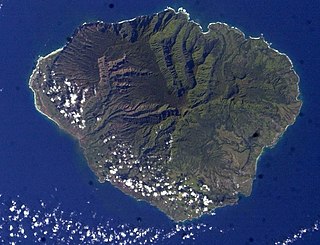
Kauaʻi, anglicized as Kauai, is geologically the second-oldest of the main Hawaiian Islands. With an area of 562.3 square miles (1,456.4 km2), it is the fourth-largest of these islands and the 21st largest island in the United States. Known also as the "Garden Isle", Kauaʻi lies 105 miles (169 km) across the Kauaʻi Channel, northwest of Oʻahu. This island is the site of Waimea Canyon State Park and the Na Pali Coast State Park.

Hanapepe or Hanapēpē is a historic, unincorporated community in Kauai County, Hawaii, United States. The name means "crushed bay" in Hawaiian, which may refer to landslides in the area. For statistical purposes, the United States Census Bureau has defined Hanapepe as a census-designated place (CDP). The census definition of the area may not precisely correspond to local understanding of the area with the same name. The population was 2,638 at the 2010 census, up from 2,153 at the 2000 census.

This is a list of properties and historic districts in Hawaii listed on the National Register of Historic Places. More than 340 listings appear on all but one of Hawaii's main islands and the Northwestern Islands, and in all of its five counties. Included are houses, schools, archeological sites, ships, shipwrecks and various other types of listings. These properties and districts are listed by island, beginning at the northwestern end of the chain.
Route 50 is a 33-mile (53 km) road that stretches from Route 56 at the junction of Rice Street in Lihue to a point approximately 1/5 mile north of the northernmost entrance of the Pacific Missile Range Facility on the western shore of Kauai. It is the longest numbered road on the island of Kauaʻi and is named Kaumualiʻi Highway.
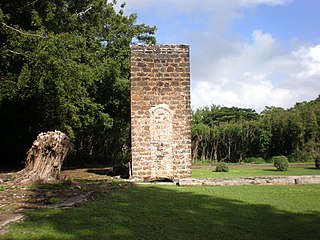
The Old Sugar Mill of Kōloa was part of the first commercially successful sugarcane plantation in Hawaiʻi, which was founded in Kōloa on the island of Kauai in 1835 by Ladd & Company. This was the beginning of what would become Hawaii's largest industry. The building was designated a National Historic Landmark on December 29, 1962. A stone chimney and foundations remain from 1840.
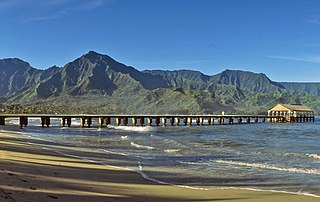
Hanalei Pier is a pier built into Hanalei Bay on the northern shore of the island of Kauaʻi in the state of Hawaii.
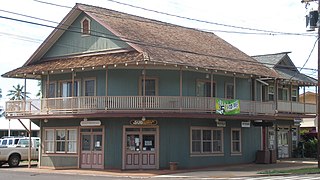
The Yamase Building at the corner of Moana Road and Kaumualiʻi Highway in Waimea, Kauaʻi, was built around 1919 by an itinerant Japanese temple architect for Seiichi Yamase, a nisei son of Japanese immigrants. Despite being the only structure of its kind in Hawaiʻi, it well represents both commercial architecture in rural Hawaii and the contribution of immigrants to the growth of commerce there. It was listed on the National Register of Historic Places in 1996.
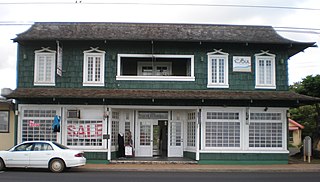
The Seto Building at 4-1435 Kuhio Highway in Kapaʻa, Kauaʻi, was earlier known as the Quality Market and then the Big Save Building. It was built in 1929 to serve as the first general food market on the island of Kauaʻi, with the latest refrigeration methods to store a variety of fresh meat and produce. Its owner, Ah Doi Seto, had immigrated from China in 1888 to work on a sugarcane plantation, but later left the plantation to open a business in bustling Kapaʻa. The building is significant as an unusual example of modern commercial architecture with Chinese design elements, but also as a forerunner of contemporary supermarkets. It was listed on the National Register of Historic Places in 1979.
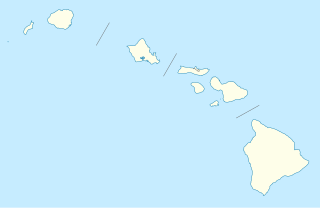
The Haʻikū Sugar Mill was a processing factory for sugarcane from 1861 to 1879 on the island of Maui in Hawaii.

Walter Lappert, at the age of 61, founded a business in Kauai to manufacture and sell "super-premium" ice cream based on family recipes from his European upbringing. He rode a wave of enthusiasm for gourmet luxury foods using fresh, high-quality local ingredients in Hawaii. Lappert's Aloha Ice Cream grew to have annual revenues exceeding $15 million in six U.S. states and produced 18,000 gallons of unique flavors of ice cream each month. Using Belgian chocolate, vanilla beans from Madagascar, local macadamia nuts, guava, and coffee beans from Kona, Lappert created a menu of 125 flavors.

There are two heritage railways in Kauai, the birthplace of Hawaiian railroading. It was added to the National Register of Historic Places on January 19, 1979.
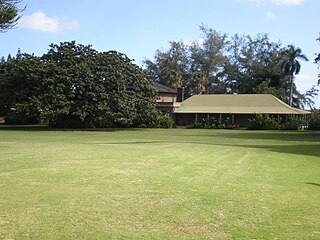
Grove Farm is a historic agricultural site on Kauai in the Hawaiian Islands.

William Harrison Rice was a missionary teacher from the United States who settled in the Hawaiian Islands and managed an early sugarcane plantation.
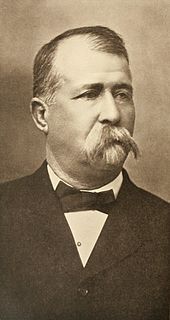
Albert Spencer Wilcox was a businessman and politician in the Kingdom of Hawaii and Republic of Hawaii. He developed several sugar plantations in Hawaii, and became a large landholder.

The Albert Spencer Wilcox Beach House was a home of Albert Spencer Wilcox. Located on Weke Road in Hanalei, Hawaii, it was listed on the National Register of Historic Places in 1993. It is a Folk Victorian-style building, with roofed lānai connecting the rooms. A 22-acre (8.9 ha) property, including five contributing buildings and four other contributing structures, was listed.

The Puʻuʻōpae Bridge is a one-lane, single-span, concrete-encased steel bridge across Kalama Stream located along Puʻuʻōpae Road between Kalama and Kīpapa Roads in the Wailua Homesteads area near Kapaʻa in Kauaʻi, Hawaiʻi, United States. Originally built in 1915, it was listed on the National Register of Historic Places in 2005.

The Kong Lung Store in Kilauea, Hawaii was originally built, in c.1941, to be the Kilauea Plantation store. It was listed on the National Register of Historic Places in 1993.

The Menehune Fishpond, near Lihue, Hawaii, on the island of Kauai, is a historic Hawaiian fishpond. Also known as Alekoko Fishpond, it has been listed on the U.S. National Register of Historic Places.

Kilauea Elementary School, also known as Kilauea School, on Kolo Rd. in Kilauea, Hawaii, on Kauai, is a public elementary school operated by the Hawaii Department of Education. It occupies a historic school building that was founded in 1882 and known as an "English School". The current school complex, whose main building was built in 1922, was listed on the National Register of Historic Places in 1983; the listing included three contributing buildings on 6.5 acres (2.6 ha).
The Kilauea Plantation or Kilauea Sugar Plantation was a large sugarcane plantation on the north side of Kauai island, Hawaii, including the community of Kilauea, Hawaii. It was owned and operated by the 1880-incorporated Kilauea Sugar Company, which became the Kilauea Sugar Plantation, Co. from 1899 on. The original property was bought by an American, Charles Titcomb, from Kamehameha IV by 1863 who used it for cattle ranching. It was sold to Englishmen John Ross and E.P. Adams, who also leased additional land from Titcomb. Ross and Adams planted sugarcane, then incorporated a firm. It was operated as a plantation from 1880 to 1971.


















